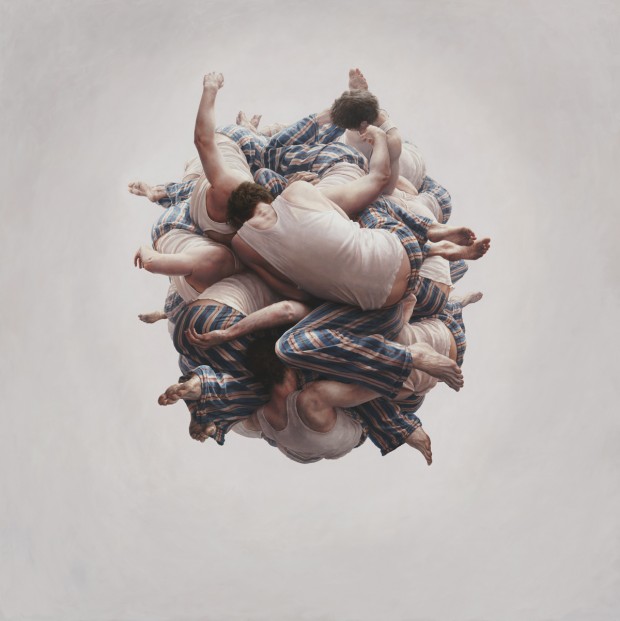An iconographic and text archive related to communication, technology and art.
☛ Jeremy Geddes: “Cluster”, oil on board, 44.5″ x 44.5″, 2011
In an interview he did with Spraygraphic two years ago, Geddes remarked about the meaning of his paintins:
Hopefully, I communicate everything I want to say through the painting itself. I’m not interested in giving it a didactic final meaning. I just want to spark questions in the viewer.
The painting depicted above could be interpreted as a graphical or even architectural study exploring the ways by which human beings can be “assemble” together in the least amount of space possible (from this perspective, it reminds me of Dan Witz “Mosh Pits” paintings). The result is a body-planet formed out of (what looks like) identical subjects. I’m left wondering what’s holding them together (or what brought them together in the first place).
Along with “A Perfect Vaccum” and his ongoing (and prolific) series about floating cosmonauts, Geddes paintings caught my attention because they all seem to address or rather raise questions about the environment we’re living in. Gravity, atmosphere, empty streets, social aggregates, broken windows and closed helmets: all of these aspects deal with the ways and the means we use in our never-ending attempt to make the world hospitable (or inhospitable: for others). The simple fact that our body can only function under certain environmental conditions points to the fundamental vulnerability of our beings. Peter Sloterdijk explores this problematic in light of the “catastrophic” historical event that is the twentieth century:
Terrorism dissolves the difference between violence against people and violence against things in the environment; it is violence against those human ―environmental ‘things’ without which people cannot remain as people. Violence against the breathing air of groups transforms the immediate atmospheric shell of human beings into something whose vulnerability or invulnerability stands open to technical control. Only in reaction to terrorist depravations could air and the atmosphere―primary means of survival in physical as well as metaphorical senses―become objects of explicit provision and aerotechnical, medical, juridical, political, aesthetic, and theoretical-cultural care. In this sense, the theory of air and the technology of climate are neither mere sediments of war and postwar knowledge, nor, eo ipso first objects of a science of peace that could emerge only in the shadows of the ‘stress of war’ (for this phrase see Mühlmann, 2004); instead, they are above all primary postterrorist forms of knowledge. (“Airquakes”, tr. by Eduardo Mendieta, Environment and Planning D: Society and Space, vol. 27, issue 1, p. 48, 2009, subscription may be required)
This quote is actually an excerpt from the introduction to volume three of Sphären or the Spheres triology. At the time of this writing, only the first volume is available in English: Bubbles. Spheres Volume I: Microspherology (see Semiotexte.com). See all previous entries about Sloterdijk on Aphelis.


Jeremy Geddes about himself:
I was born in NZ, but grew up in Geelong, these days I live in Brunswick, Melbourne. I’ve been painting full time since 2003, before that I was working in video game development, and before that art school. (Australian Edge: “Interview with Jeremy Geddes”, May 2009)
More online resources about Jeremy Geddes:
- Make sure to check his official website. Likewise, one can subscribe to his blog in order to stay informed about his activities. Alternatively, one can follow him on Facebook. Geddes sells prints of his painting. At the moment, they are all sold out.
- Jeremy Geddes was recently featured in the art magazine Juxtapoz (one of his painting made the cover): Juxtapoz Magazine February, February 2012, cover #133. It’s possible to preview the magazine and buy it online. PNG images from the material related to Jeremy Geddes were made available online at the Expresso Beans’s forum.
- Geddes was also featured in Schön! magazine back in November 2010: “The White Astronaut. Artwork / Jeremy Geddes” by Sarah Fox, Number 9, pp. 58-67. Providing a valid email address allows for browsing a Flash version of the magazine. Images of the spreads were also made available over at CoolPima’s blog.
- Finally, an interview from 2008 over at beinArt Collective & Publishing: “Interview with Jeremy Geddes” March 26, 2008.
- By Philippe Theophanidis
- on
- ― Published in Art, Communication, Painting
- Tagged: astronaut, atmosphere, body, community, environment, gravity, hyperrealist, Jeremy Geddes, Sloterdijk, space, sphere

